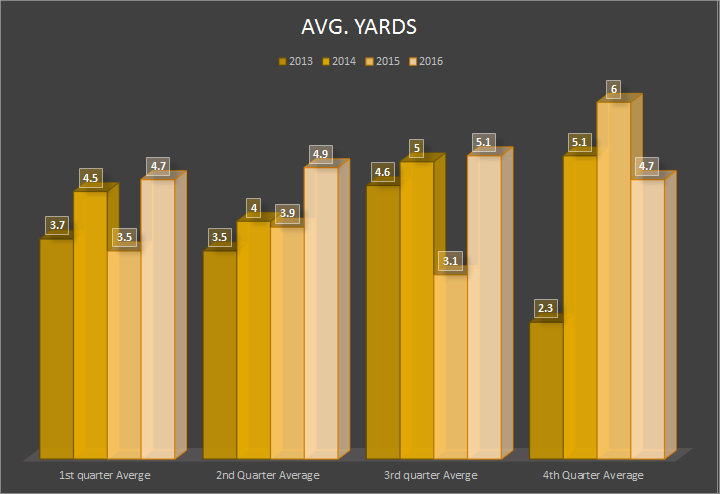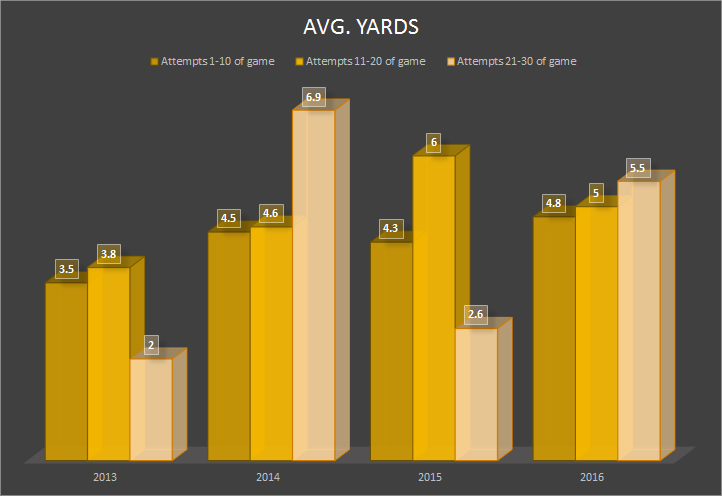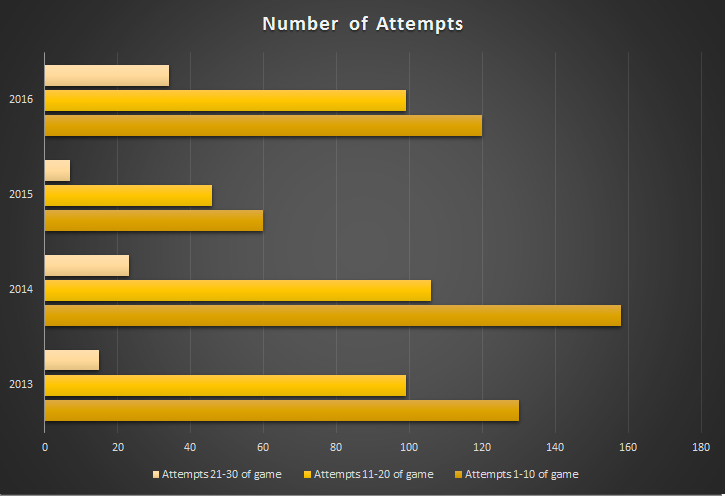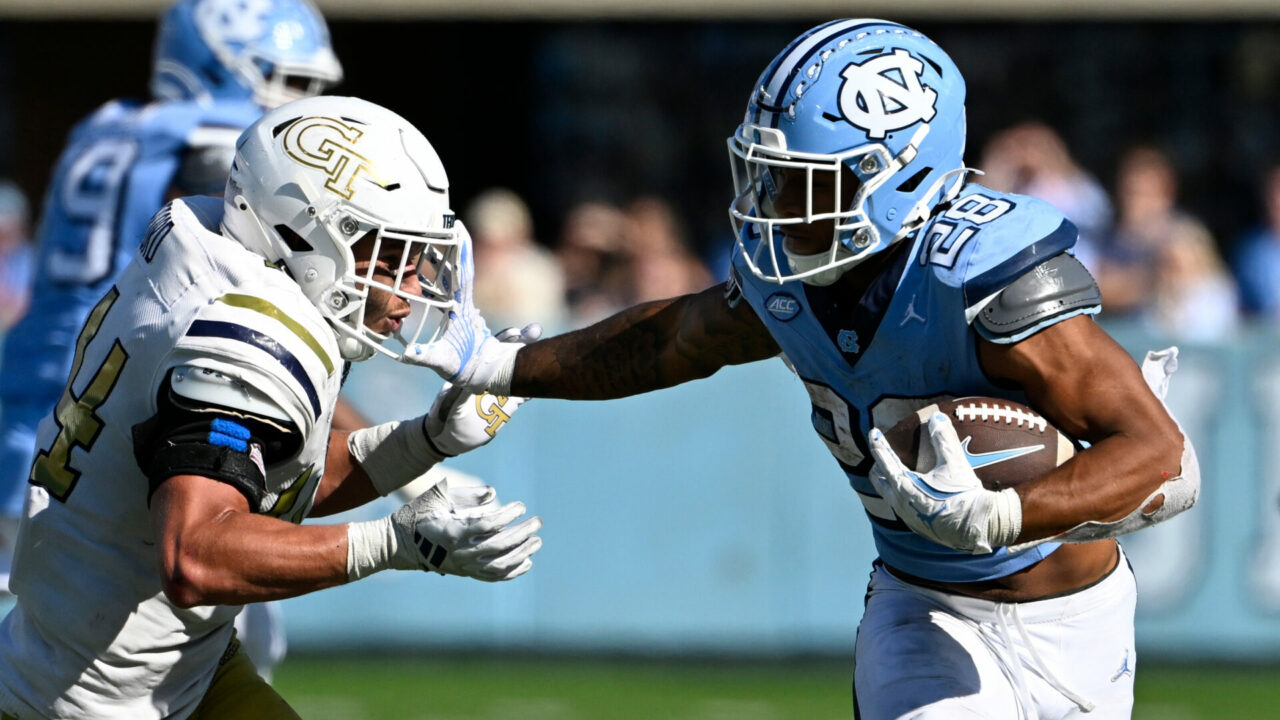Analysis: Le’Veon Bell gets better as the game goes on
No surprise Le’Veon Bell has been on the tip of everyone’s tongue lately. With the anticipation of a deal that eventually came to nothing and the ensuing drama about Bell playing on the franchise tag, he’s been a hot topic lately.
One thing that surprised me during all this conversation was some commentary that indicated that some folks think Le’Veon is a first half back: one who piles on stats in the first two quarters and then disappears for the rest of the game.
I wasn’t sure that I believed that because frankly, it doesn’t even fit the paradigm of how the Steelers play. Bell’s numbers should be stronger in the second half when the Steelers are trying to fritter away time and salt away the lead.
After looking at the numbers, I understood why some might believe he’s only a first half player, but when you dig a little deeper, you’ll find that this really isn’t the case.
First Half Numbers
In order to gauge whether Bell is a “one-half wonder,” we need a baseline: how well does he run in the first half?
To determine this, I’m going to use what I think is the best statistic to measure effectiveness: average yards per attempt. So to start things off, the following shows Le’Veon Bell’s average yards per attempt during the first half of games for his career:

Bell has improved on his per carry average nearly every year, topping out at 4.8 yards per carry in both 2015 and 2016. In 2016, the NFL average for yards per attempt was 4.17, and it’s no surprise that Bell was well above that average.
Looking at these numbers a little more granularly, here is the breakdown by quarter for the first half:

In both 2013 and 2014, Bell’s second quarter numbers took a dip versus his first quarter numbers. In 2015 and 2016, that trend changed, where he improved on his yards per carry average.
Let’s realize that these “by quarter” numbers can be wildly skewed based on the number of attempts Bell is given. The narrative that he racks up yards in the first half and fades away in the second would seem to gain a little ground when looking at only his 2013 and 2014 numbers. His yards/attempt average dropped in the second quarter, but in the past two seasons, that hasn’t been the case.
Overall, as an average for his career, Bell’s first and second quarter yards per attempt are nearly identical.
Now that we have a baseline, let’s compare those numbers to the numbers Bell puts up in the second half of games.
Second Half Numbers
One important thing to remember about the second half – if in fact, the Steelers are trying to seal a victory by running Bell, the other team is going to be aware of that, and load up the box as best they can to stop him.
It actually sets the stage for Bell being less effective in the second half.
However, when you look at his first half yards per carry average versus the same stat in the second half, you can see that only in Bell’s rookie year did he have less average yards per carry in the second half (3.6 to 3.4). Every other season he was either as good, or better in the second half.

As we did with the first half, let’s look quarter by quarter to see if anything is buried inside those second half numbers.

Again, you can see that other than his rookie season, Bell had a higher per carry average in the fourth quarter in both 2014 and 2015, and he only fell slightly lower than his 1st half numbers in 2016 (4.7 to 4.8 average). That doesn’t seem like a guy who fades away as the game goes on – even though it’s likely that teams are gearing up to stop him.
Bell’s patient running style actually helps him in the second half. Opposing defenses can’t help but be worn down to some extent with the Steelers front five banging on them after three quarters, and Bell forcing them to work to chase him and eventually bring him down. By the second half, they simply may not be capable of reacting quickly enough when Bell changes direction or finally makes a cut after patiently waiting for a hole to develop.
The idea that Bell’s performance drops off in the second half doesn’t seem to fit these numbers. Still, there is another way to measure his effectiveness as the game wears on, so let’s dig a little deeper.
Digging Deeper
A number of running backs in the history of the NFL have been said to get “stronger” as the game goes on. The idea is that they are more productive on their latter carries than they are on their first carries.
Whether you think the back needs to get into the game, he needs to get that first taste of contact to get him focused, or if you think it’s just because the opposing defenses are worn down later in the game, if the idea that Bell is a better first half back than a second half back is to be believed, then you would expect his production to dwindle the more carries he gets.

This chart shows Bell’s average yards per carry based on breaking down his attempts into thirds: 1-10, 11-20, and 21-30.
In both 2014 and 2016, Bell appears to get stronger as the game goes on. In fact, that also seems to be true in 2013 and 2015 for the first 20 carries.
Part of the reason the pattern breaks down is that, in both 2013 and 2015, Bell got fewer attempts that were in the 21-30 range, as shown in this graphic:

If the Steelers are trying to close out games running the ball more heavily, you would expect Bell’s attempts in the second half to be greater than those in the first. That hasn’t been the case, other than in 2016.
In every other year of Bell’s career, he has received fewer carries in the second half.
What these numbers appear to show is not a player who only shows up in the first half.
Conclusion
I get it – we often take the last thing we remember and use that as a touchstone for all things. The last memory we have of Le’Veon Bell, from an on-the-field perspective, is him not being around for the end of the AFC Championship game.
That’s not his fault, as he was injured and couldn’t go, but it is understandable why some fans might think he’s only available during the first half of games.
The other narrative is that he is only around during the regular season, and that is one that is harder to argue with; however, we should remember that in the two games prior to the AFC Championship, Bell put up record-setting performances in back-to-back weeks.
The bottom line is this – Bell has proven to be a player who can be depended on for the entire game. He is at least as effective, if not more effective, in the second half of games.
Yes, keeping him healthy so that he can bring that productivity to a full schedule of games is important, and maybe even critical to the Steelers ultimate success. But let’s not undervalue Bell’s accomplishments. Without those “regular season” stats, the Steelers don’t make it to the second season to begin with.








